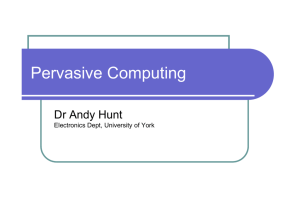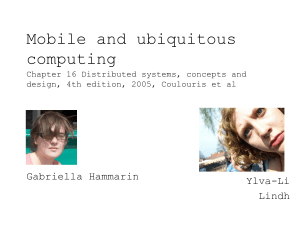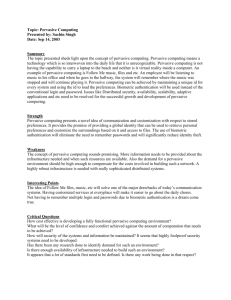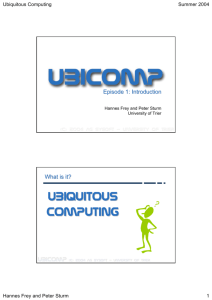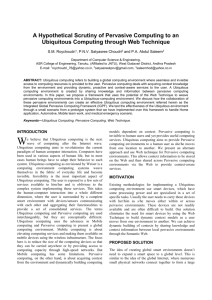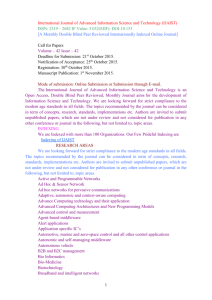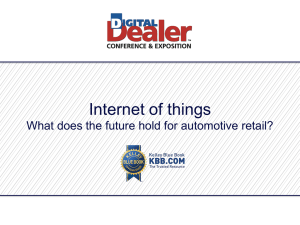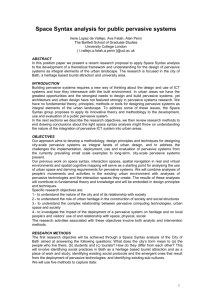A short history of computers and IT… - LIRIS
advertisement
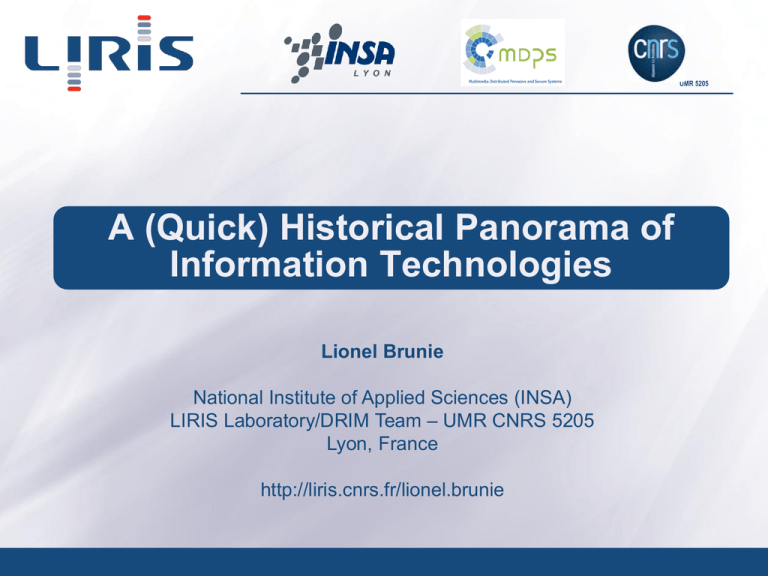
UMR 5205 A (Quick) Historical Panorama of Information Technologies Lionel Brunie National Institute of Applied Sciences (INSA) LIRIS Laboratory/DRIM Team – UMR CNRS 5205 Lyon, France http://liris.cnrs.fr/lionel.brunie Agenda Back to (pre-)History A Quick Look at Cutting-Edge IC Technologies Super Computing Large Scale Computing: Grid and Cloud Computing Mobile, Ubiquitous and Pervasive Computing The Internet of Things How all this has happened? Technological Evolutions Software Evolutions 2 A short history of computers and IT… 60 years ago… 3 A short history of computers and IT… 25 years ago… 4 A short history of computers and IT… Today… 5 A short history of computers and IT… Tomorrow ? 6 A Quick Look at Cutting Edge IT Let’s have a look at cutting edge IT Super Computing Grid and Cloud Computing Mobile, Ubiquitous and Pervasive Computing The Internet of Things Super Computing From Vector Machines to Clusters Old times Basic ideas A super computer is like a Ferrari → use specific components Super computing is like F1 or WRG → adapt to the application scenario Vector Computer (Cray) Database Computer An alternative idea: Super SIMD (Connection Machines) Incredible creativity in architecture and network design A Cray-2 2013… The Tianhe-2 (Milky Way-2) Ranked 1st in the top500 list of the most “powerful” (computing intensive) computers (June 2013) Ranked 6th in the graph500 list of the most “powerful” (data intensive processing) computers (June 2013) Ranked 32nd in the green500 list of the most energy efficient computer (June 2013) China (National University of Defense Technology) 11 2013… The Tianhe-2 (Milky Way-2) Rmax = 33862 (i.e., 33,9 Pflops) – Rpeak = 54902 (computing efficiency : 61,7 %) 3,120,000 cores – Memory: 1.375 PB – Disk: 12,4 PB –fat-tree based Interconnection Network 16000 computer nodes 1 node = 2 Intel (12 cores) Ivy Bridge Xeon + 3 (57 cores) Xeon Phi co-procs + 88GB memory shared by the Ivy Bridges procs + 8 GB memory shared by the Xeon Phi chips Power:17,8 MW (1,9 Tflops/kW – 1,9 Gflops/W … only!) « Tianhe-2 operation for 1 hour is equivalent to 1.3 billion people calculator operating one thousand years » (best-news.us – assertion not checked) 12 2013 #2… The Titan (Cray XK7) Ranked 2nd in the top500 list (1st in Nov. 2012) 299008 cores – Memory: 710 TB – Cray Gemini Interconnect 18688 Opteron 6274 16 cores 2.200GHz + 18,688 Nvidia Tesla K20X GPUs Rmax = 17590 – Rpeak = 27112 (computing efficiency : 65 %) Power: 8.2 MW… only! 13 Supercomputing… A Quick Look at the Web Top500.org performance development logarithmic progression! (x10 in 3years) clusters, clusters (84%)! 54% in industry max power efficiency: 2.9 Gflops/W #500: 96 TFlops! – Total : 223 Pflops poster Top500 Graph500.org BlueGene++ Green500.org and GreenGraph500 List max: 3,2 Gflops/W #1 green500 = #467 top500 (1 T00flops) #1 top500 = #32 green500 Large Scale Computing: the Grid Resource Sharing and Cooperative Computing in Large-Scale Dynamic Virtual Organizations Grid Computing… The LCG Architecture Trigger and Data Acquisition System Tier-0 Tier-1 10 Gbps links Optical Private Network (to almost all sites) Tier-2 General Purpose/Academic/ Research Network From F. Malek – LCG FRance 16 Grid Computing: Applications High energy & nuclear physics Simulation Earth observation, climate modeling Geophysics, earthquake modeling Fluids, aerodynamic design Pollutant dispersal scenarios Astronomy- Digital sky surveys: modern telescopes produce over 10 Petabytes per year (upto 30 TB per day)! Molecular genomics Chemistry and biochemistry Financial applications Medical images … Large Scale Computing: the Cloud Business-centric Large-Scale Distributed Computing Everything as a Service Cloud Computing “A large-scale distributed computing paradigm that is driven by economies of scale, in which a pool of abstracted, virtualized, dynamically-scalable, managed computing power, storage, platforms, and services are delivered on demand to external customers over the Internet” (Foster at al.) SalesForces, Amazon, IBM, Google, Microsoft, Backblaze… Everything as a service Infrastructure as a service Platform as a service Software as a service Behind the scene: some kind of a (proprietary) grid 19 Mobile/Ubiquitous/Pervasive Computing A Focus on the User Mobile/Ubiquitous/Pervasive Computing Mobile communications have freed the user from the Internet plug 3G/4G mobile Internet is as faster as Internet-at-work and Internetat-home Ubiquity, i.e., Internet-everywhere, is a reality (at least in Western countries) A dramatic social (and business) change! A still-open issue: context-awareness what is your device, what are the network conditions? where are you? what are you doing right now and in the near future? what are your preferences? Who are your friends? … Applications of Ubi./ Perv. Computing Sensor networks (smart dust) Home networks Patient monitoring (personal area networks) Emergency management / battlefield / borders monitoring Museums and pervasive buildings Vehicular Ad hoc NETworks (VANET) / MANET Alert management (parking, kids, etc.) Supply chain U-Society People to People (P2P): Facebook on your cell phone People to Object (P2O): IoT platforms Geopositioned Services: App Store Do-IoT-Yourself: Arduino / Raspberry Pi / Beaglebone - Fab Lab ? … 22 The Internet of Things When (Smart) Things Meets Internet The Internet of Things: Definition The « Internet of Things (IoT) is […] a dynamic global network infrastructure with self configuring capabilities based on standard and interoperable communication protocols where physical and virtual ‘things’ have identities, physical attributes, and virtual personalities and use intelligent interfaces, and are seamlessly integrated into the information network. In the IoT, ‘things’ are expected to become active participants in business, information and social processes where they are enabled to interact and communicate among themselves and with the environment by exchanging data and information ‘sensed’ about the environment, while reacting autonomously to the ‘real/physical world’s events » (CERP-IoT) 24 Applications of the Internet of Things IoT platforms yet exist: xively (ex-cosm, ex-pachube), sen.se, etc. Machine To Machine (M2M) / Object To Object (O2O) the never lasting intelligent fridge ? smart maintenance « Intelligent » sensors networks smart factory ITS and Smart car … What place for humans? 25 The Internet of Things Key words Identity / Personality Autonomy Interaction / Environment Communication / Global Network A philosophical approach: Spimes (Bruce Sterling, 2004)? A promise with no future? A nightmare? A dream? The true future? 26 A Universal Network of Things ? From readwrite.com 27 An Infinity of Networks of Things From readwrite.com 28 How all this has happened? 29 Technological Evolutions Large bandwidth communications Optical fiber 3G, 4G, WiMax WiFi Direct Low power local communications NFC Zigbee, Bluetooth… « Universal » identification RFID - Electronic Product Code (EPC) – EPCGlobalNetwork – Object Naming Service (ONS) IETF Host Identity Protocol (HIP – RFC 4423-5201 ) Geopositioning GPS/Galileo GSM 30 Technological Evolutions (Cont’d) Supercomputing Parallel supercomputers (1- Tianhe-2 - 34 Pflops) Super-clusters/clouds (Microsft = 1 million of servers (July’13) ; Google 2+ millions of servers? Soon 10 millions?) Super storage Key: ~GB Disk: ~TB Data Center: ~PB Micro-Nano technologies Sensors – Sensor networks “Things” Convergence digital camera – telephone – laptop → smartphone 31 Software Evolutions Services – SOA Object Service / Service Object (Everything as a Service) Social networks E-Services Mobility (M-services) “All digital, any where, any time” Era 32 Back to Ubiquitous/Pervasive Computing 33 Ubiquitous and Pervasive Computing… The Vision of a Calm Technology « The most profound technologies are those that disappear. They weave themselves into the fabric of everyday life until they are indistinguishable from it » [The objective of pervasive computing is to ] “ … make a computer so imbedded, so fitting, so natural, that we use it without even thinking about it.” “Ubiquitous (pervasive) computing is roughly the opposite of virtual reality. Where virtual reality puts people inside a computer-generated world, ubiquitous computing forces the computer to live out here in the world with people.” « A new way of thinking about computers in the world, one that takes into account the natural human environment and allows the computers themselves to vanish in the background » Mark Weiser, Xerox PARC, 1991- Ubiquitous and Pervasive Computing… The Vision of a Calm Technology [M. Satyanarayanan, 2001] Pervasive computing environment = « one saturated with computing and communication capability, yet so gracefully integrated with users that it becomes ‘a technology that disappears’ » So: “Smart” spaces “Invisibility” and transparency Scalability 35 Some Key Ideas for an Holistic Vision The « object-subject » is actor (a first-class citizen) of the “system” / of the Future smart objects / smart everything active objects “the” cloud « Intelligence » is, at first, the « network » i.e., the ability to exchange information / communicate « Intelligence », is also the ability to self-adapt to the user profile and the context (« context awareness »), “to weave” into the environment « Ego » is part of the context « Intelligence », finally, is the ability to organize: autonomously (autonomic computing, self healing…) spontaneously Multi-Scale Ubiquitous Ego-Centric Digital Ecosystem 36 A Partial Conclusion An incredible change! A digital world (and digital life) An (almost) unlimited power of processing, storage, communication Unlimited opportunities of new applications But a coined in the 60’s client-server way of thinking! And strong concerns about privacy (A Highway to) Hell or Eden? What IT world do you want to build ? 38

